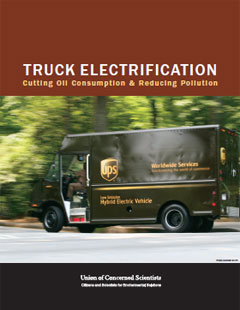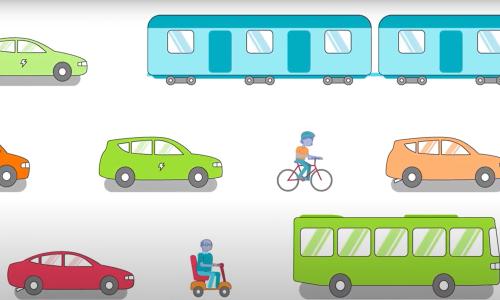Medium- and heavy-duty vehicles represent only 4 percent of U.S. vehicles, but account for about 20 percent of the transportation fuel we consume.
Advanced vehicle technologies — similar to technologies used in today's hybrid and electric cars — have the potential to dramatically reduce fuel consumption, cutting fuel costs for businesses, improving air quality and public health, and moving the country towards cutting its projected oil use in half within the next 20 years.
As this survey of the development and deployment of electric truck technologies demonstrates, battery, fuel cell, and hybrid powertrains are already at work in today's commercial vehicles — and are poised to expand in the years ahead.
Hybrid-electric trucks
Hybrid-electric trucks achieve increased fuel efficiency by combining a conventional internal combustion engine with an electric motor, batteries, and braking-energy capture (known as regenerative braking).
- Fuel-consumption reductions of 20 to 35 percent are possible with current hybrid truck technology, according to a review by the National Academy of Sciences.
- Commercial production of the first hybrid delivery truck began in 2007. Today several manufacturers offer hybrid models, and thousands of hybrid systems are being used in applications ranging from public-transit buses to package- and beverage-delivery trucks.
Battery electric trucks
Battery electric trucks have no internal combustion engine and are instead propelled by an electric motor powered by onboard batteries. The range of a current battery electric truck varies, depending on the load it carries and the capacity of its batteries, from 50 to 100 miles per charge.
- Urban delivery trucks, which travel short and well-defined routes, are less constrained by battery range and ideal candidates for full electrification. Companies such as AT&T, Frito-Lay, and Staples have all added electric delivery trucks to their fleets.
- Yard hostlers, which move cargo containers at ports and warehouse complexes, also represent an excellent opportunity for all-electric technologies.
Fuel cell electric trucks
These electric trucks are powered by fuel cells, which convert hydrogen and air into electricity while emitting only water vapor.
- The Port of Los Angeles is evaluating fuel cell electric trucks for "drayage" operations, which usually entail short-distance freight movement such as conveying cargo containers from a port to a rail yard or warehouse. The fuel cell trucks have a potential range of up to 400 miles between hydrogen refuelings and can each save an estimated 6,000 gallons of diesel fuel per year.
External electric power
Like light-rail trains or trolley cars, trucks can be designed to run on electricity that is supplied externally as needed.
- The ports of Los Angeles and Long Beach are planning demonstrations of a caternary system (pictured) that would enable a hybrid-electric truck to run on power supplied by overhead lines. When off the caternary section, it would operate like a regular hybrid-electric vehicle.
Other technologies
Some electric technologies do not directly move the truck but can still reduce its fuel consumption.
- Battery-powered auxiliary power units can provide power to the cabs of long-haul trucks when the drivers are sleeping or resting during multi-day trips. Traditionally, drivers leave the truck idling to provide heating, cooling, or electricity to power appliances — a practice that consumes as much as 1,400 gallons of diesel each year.
- Plug-in refrigeration units eliminate the need to operate on-board diesel generators while the truck is parked to maintain the proper temperature for transporting perishable goods such as fresh produce and frozen items.
- Export power or power take-off systems supply the energy to run external equipment such as lights, pumps, and aerial lifts. Traditionally this power is provided by the truck's internal combustion engine, but converting these systems to battery power enables operators to shut off the engine when parked at the work site.




